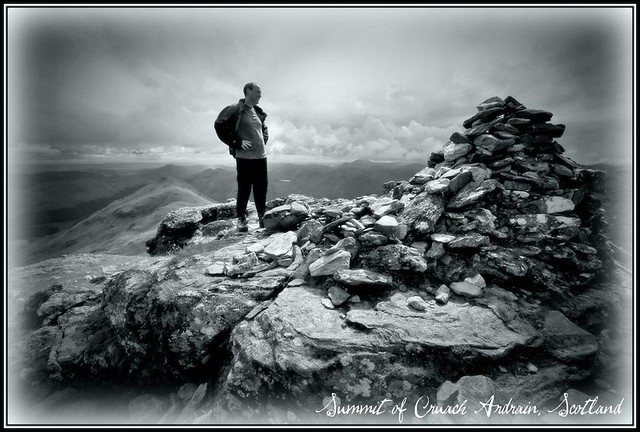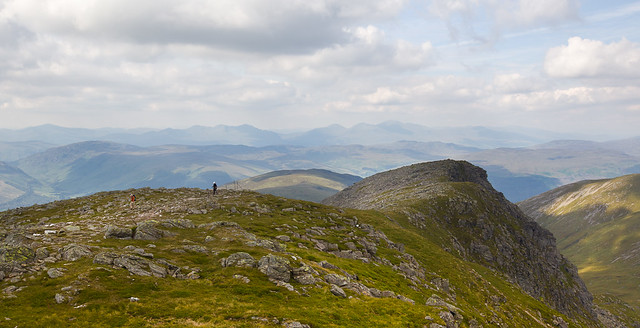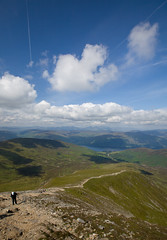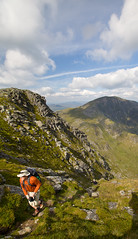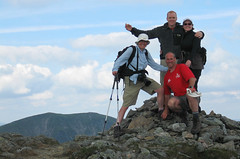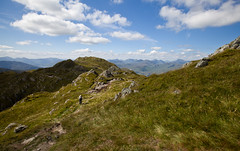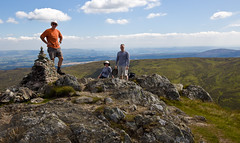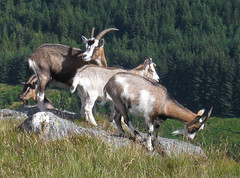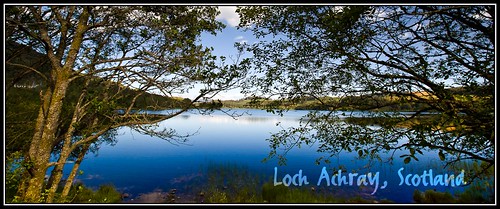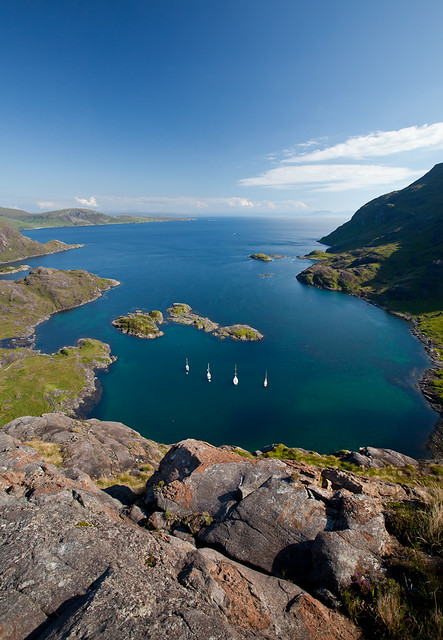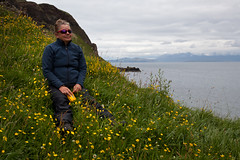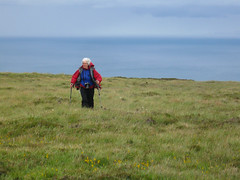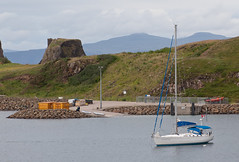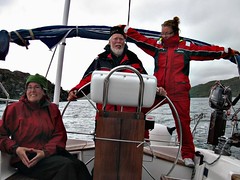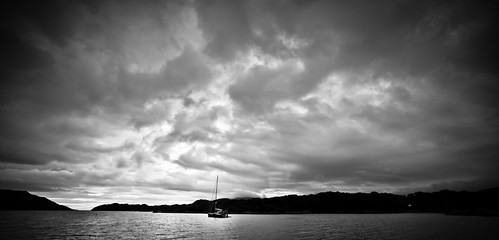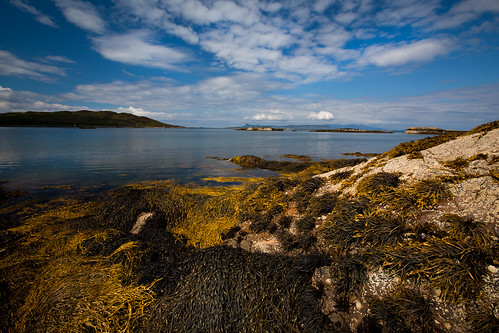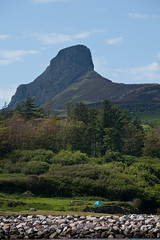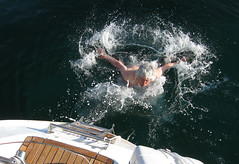In the Scots language of Robbie Burns "oo stravaig" means "we wander", and, as our time in Scotland comes to an end, I can honestly say Mike and I have done our share of wandering. One of our favourite areas to undertake a wee stravaig turned out to be the hills above the West Highland village of Crianlarich. There are seven Munros (mtn. over 914m/3000ft) accessible from town and we've been on all of them. From massive Ben More in the east to craggy Beinn Chabhair in the west, hill walkers in Crianlarich are spoiled for choice.
We've been to the area three times and accessed all start and end points via the bus and Shank's mare. Ben More and Stob Binnein brought us out for a beautiful day in early June (reported on in A Scotland Season - June 3). We next visited on Aug 5th, when we bagged three Munros: Beinn Chabhair (meaning Antler Mountain, pronounced Ben Chavir, 933m/3060ft), Beinn a'Chroin (Mountain of Danger, Ben a Chraw-in, 946m/3103ft) and An Caisteal (The Castle, An Cash-tyal, 995m/3264ft). Our third visit was on Aug 17 when we did Cruach Ardrain (High Mound, 1046m/3431ft) and Beinn Tulaichean (Hill of hills, Ben too-leach-an, 946m/3104ft).
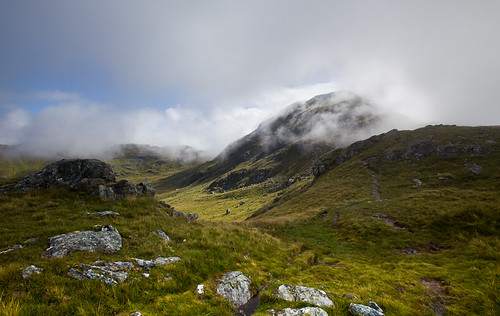 |
| Mist rising off Cruach Ardrain |
Another difference - More and Binnein are frequently travelled. Unless one climbs these mountains in a downpour, other hill walkers will be a common sight. Actually, this is Scotland, and just a downpour wouldn't keep the Scots out of the hills. Indeed, on our worst day of hiking (July 5), when we were forced down from Ben Vane (the smallest of the Munros) by poor weather we encountered an older fellow on the trail. He had already scrambled up and was on his way down. On passing us by he noted "Aye, it's a wee bit damp today, but a fine walk for all that".
But, I digress -- More and Binnein, with their ease of access, and straightforward, if somewhat strenuous approaches, are hiking magnets, while the other five are not so busy. Probably because they are difficult to access and have some tricky navigation and/or scrambling components to work through. Indeed, on our Aug 17 trip we saw no one in eight hours of hiking -- and the day was stunning.
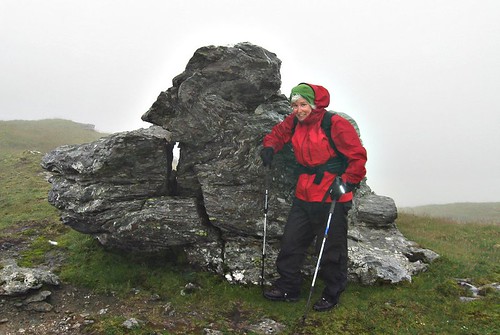 |
| Mary, about to be entertained on the Beinn a'Chroin ridge |
People have asked what I find so entrancing about the Scottish hills, especially when we have such majestic mountains back home. Of course, I love the Selkirks, Monashees, and Rockies, the mountains of my youth in British Columbia's interior. And I look forward with great anticipation to reuniting with my old friends, the Sooke Hills of southern Vancouver Island. But I know I'll miss the amazing washes of light through clouds, the blue-on-blue ranks of tops marching into the horizon, and the understated challenge of getting up and down. Sure, these are not high mountains, but, as with so many enjoyable pursuits, size isn't everything! Indeed, when you read in a Scottish mountain guidebook that a steep cliff "provides an interesting diversion", or a narrow ridge "posses little difficulty" get ready to be entertained. Certainly, a few steps on Ardrain and Beinn a'Chroin fell into the "interesting diversion" category.
All in all, Mike and I have been endlessly entertained on our hill walking expeditions thus far, and hope to get in several more jaunts before winging back to BC. I'll be sorry to leave these mountains, but will look forward to putting Scottish-based rambling skills to work in my home mountains. My goal will be to find an interesting diversion on each and every stravaig; get ready everyone, I'll be bringing a wee bit o'the Bonnie Highlands of Sco'land back in both my feet and my heart.
Aug 5th - Beinn Chabhair, Beinn a'Chroin, An Casteal
View Beinn Chabhair, Beinn a'Chroin, An Casteal in a larger map
Aug 17 - Cruach Ardrain and Beinn Tulaichean
View Cruach Ardrain and Beinn Tulaichean: Aug 17, 2011 in a larger map
More pictures from Chabhair, a'Chroin, and Casteal
More pictures from Ardrain and Tulaichean.
